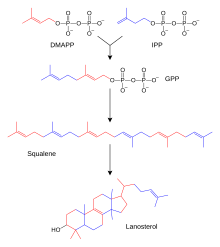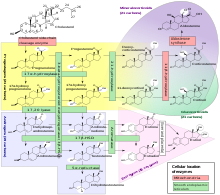A steroid is a organic compound, either natural or man-made, which has four cycloalkane rings in its structure. Plants, animals and fungi make hundreds of different natural steroids.[1]
Steroid hormones are steroids which act as hormones in the body. Natural steroid hormones are usually made from cholesterol in the adrenal glands and gonads. Cholesterol is a plentiful steroid in animal cells: it is important for cell membranes.
Examples of steroid hormones include
One review noted: The adrenal gland hormones play a vital role in adapting to "ever-changing environmental and emergency situations, and help vertebrates in their successful survival".[2]
Prednisone is an important man-made steroid medication, used to treat inflammation.
Medical use
Some steroid hormones are anabolic steroids (AAS). Since the discovery and synthesis of testosterone in the 1930s, AAS have been used by physicians for many purposes, with varying degrees of success:
- Bone marrow stimulation: For decades, AAS were the mainstay of therapy for hypoplastic anemias due to leukemia or kidney failure, especially aplastic anemia. AAS have largely been replaced in this work by synthetic protein hormones that stimulate growth of blood cell precursors.
- Growth stimulation: AAS can be used by pediatric endocrinologists to treat children with growth failure. However, the availability of synthetic growth hormone, which has fewer side effects, makes this a secondary treatment.
- Stimulation of appetite and preservation and increase of muscle mass: AAS have been given to people with chronic wasting conditions such as cancer and AIDS.
- Hormone replacement for men with low levels of testosterone; also for improving libido in elderly males.
- Stimulation of lean body mass and prevention of bone loss in elderly men, as some studies indicate. However, a 2006 placebo-controlled trial of low-dose testosterone supplementation in elderly men with low levels of testosterone found no benefit on body composition, physical performance, insulin sensitivity, or quality of life.
- Induction of male puberty: androgens are given to many boys distressed about extreme delay of puberty. Testosterone is now nearly the only androgen used for this purpose. It has been shown to increase height, weight, and fat-free mass in boys with delayed puberty.
- In low doses as a component of hormone replacement therapy. Testosterone is usually used for this purpose, although methyltestosterone is also used.
- Treatment of osteoporosis in postmenopausal women. Although they have been approved for this, there are "virilizing side effects" (made women look more male).
- Treatment of breast cancer in women, although they are now rarely used for this purpose.
- Male contraception, in the form of testosterone enanthate; there is a potential for use as a safe, reliable, and reversible male contraceptive.
Abuse
Certain anabolic steroids, such as testosterone, are used to help make muscles stronger. Such steroids are used to improve a person's performance, but they are sometimes overused and abused by athletes. The rate of steroid abuse grew greatly in the early 21st century, all over the world. Overuse of anabolic steroids can have bad effects on the human body. They can cripple or kill. Sports organisations now regulate their use.



